|

 Up
Up 
 The 1901
The 1901
Wright Glider

(You are here.)
The
1903
Wright
Flyer I

The
1905
Wright
Flyer III





  Need
to Need
to
find your
bearings?
Try
these
navigation aids:
If
this is your first
visit, please stop by:
Something
to share?
Please:



|
|
Available in Française, Español, Português, Deutsch, Россию,
中文,
日本, and others.
 he 1901 glider was larger, more sophisticated, and
better engineered than their first flying machine -- or so the Wright brothers
hoped. It had almost twice as much wing surface to increase lift, a deeper
camber, curved front skids, a raised elevator, "belly" skids, a
control system with more mechanical advantage to make it more effective, and
other improvements. Unfortunately, it wasn't half the flying machine the Wright
brothers hoped it would be. It still did not produce enough lift to suit
them. And the wide wings and the deep camber made the controls less effective
than on the 1900 glider. The Wrights trussed the wings to reduce the depth of
the camber and some of the control effectiveness returned, but it still was a
poor performer by any aerodynamic standard. he 1901 glider was larger, more sophisticated, and
better engineered than their first flying machine -- or so the Wright brothers
hoped. It had almost twice as much wing surface to increase lift, a deeper
camber, curved front skids, a raised elevator, "belly" skids, a
control system with more mechanical advantage to make it more effective, and
other improvements. Unfortunately, it wasn't half the flying machine the Wright
brothers hoped it would be. It still did not produce enough lift to suit
them. And the wide wings and the deep camber made the controls less effective
than on the 1900 glider. The Wrights trussed the wings to reduce the depth of
the camber and some of the control effectiveness returned, but it still was a
poor performer by any aerodynamic standard.
What was more frustrating is that the Wright brothers put
everything they knew into building this glider. In many ways, it encompassed the
sum total of nineteenth aeronautical wisdom, and still it was not enough to
produce a decent glider. The Wrights had no idea what else they might do. The
left Kitty Hawk early, completely stymied. On the trip home, Wilbur remarked to
Orville that man might still fly, "but it won't be in our lifetimes, not in
a thousand years."
We built this replica f the 1901 Wright Glider to celebrate the 100th anniversary of
the 1901gliding experiments. These may not seem like much to celebrate as this
is perhaps the Wright brothers least successful flying machine. But true
scientific achievement is rarely built on success alone. Science is a way to
learn from both success and failure -- both play an essential role in the
advancement of knowledge. The 1901 Wright Glider, as unsuccessful as it may have
been, was an important step in the invention of the airplane for the simple
reason that it helped the brothers define what it was that they didn't yet know.
|
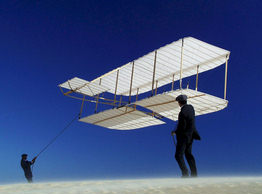
Kiting the 1901 Wright Glider for the PBS film,
Kitty Hawk: A Journey of Invention.
|
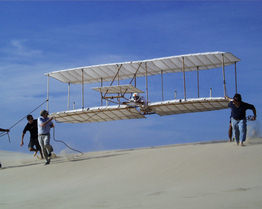
Launching the 1901 Wright Glider.
|
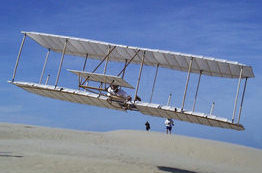
The 1901 Wright Glider in flight.
|
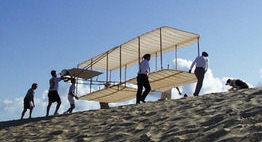
Carrying the 1901 Wright Glider up the sand dunes at Jockey's Ridge
State Park in North Carolina.
|
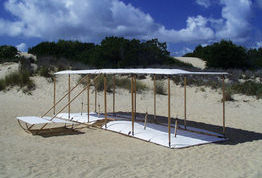
The 1901 Glider replica as it appears looking at it
diagonally from the left and front. It is the most complex and the
worst flying of the three experimental gliders .
|
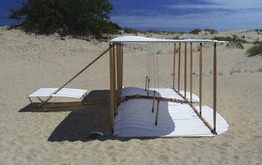
The glider from the side
– like the 1900 glider
before it, the rear spar
is on top of the ribs instead of under them. Again, the Wrights were
thinking to keep the underside of the wing smooth to generate maximum lift.
|

The glider diagonally from the left rear. As in
1900, the rear spar acts as a spoiler and reduces
the lift. This may account for some of the discrepancy between the lift
they calculated and the lift they actually measured.
|
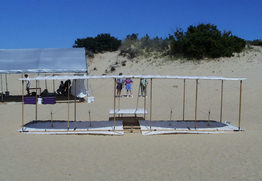
The glider straight on from the rear. The Wrights
continued to use the same rigging system they had the year before. By tensioning just four wires on the airplane, they could
tune all the flying and landing wires.
|

Another diagonal view – that's our
"hangar" in the background. Actually, it's a large tent that the
rangers at Jockeys Ridge State Park gave us permission to erect,
and then kindly helped us carry the poles and tarps back
into the dunes. Many thanks!
|
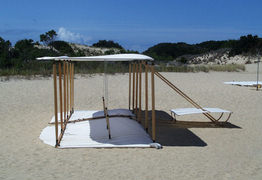
The 1901 glider from the right side. The wide wings
give the glider a low "aspect ratio" – the wingspan divided by
the chord is just 3.1. After their wind tunnel tests, the Wrights would
learn that a low aspect ratio is inefficient. The 1902 glider would
have an aspect ratio of 6.4.
|
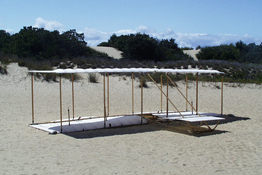
The glider seen from the right front, at a diagonal.
Note that it has no tail. At this point, the Wrights still think they can
control a glider with elevator and wing warping only. When they try to
turn this glider in flight, they'll have their first brush with
"adverse yaw" – the glider will yaw in the opposite direction
of the roll.
|
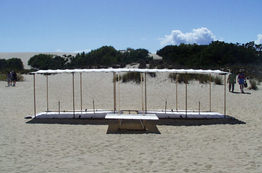
The glider from the front. All those wires –
rigging and trussing – create an enormous amount of drag in the air.
That's another reason this machine is such a poor flier.
|
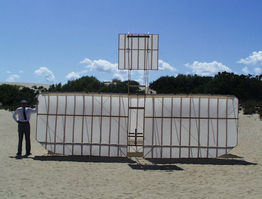
The 1901 glider seen from the bottom, held by David
Thompson, an Orville Wright look-alike. Compare this to a
photo taken a century earlier by clicking
HERE.
|
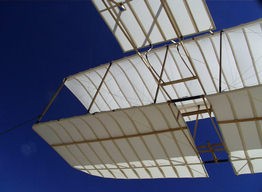
Another view of the bottom of the glider as it's
being kited. And yes, the sky really is that blue on a good day at
Kitty Hawk.
|
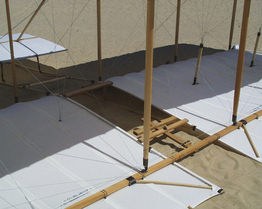
A view of the cockpit. You
rest your belly on the "belly bar" (spanning the highest point
in the camber), grasp the elevator control
bar with your hands and place your feet against the kickbar.
|
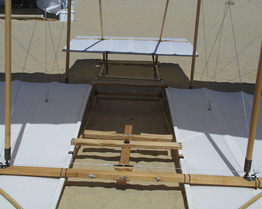
This is what it looks like as you step into the cockpit. To control
the glider, you twist the elevator control bar up to go down and
down to go up. This kickbar is a little better –
kick right to roll right and left to roll left.
|
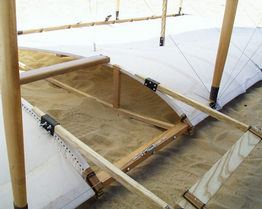
A close-up of the cockpit, showing the skids and the extremely high
arc of the wings. The ribs on either side of the pilot remain at a
1:12 camber; they cannot be flattened with the trussing.
|
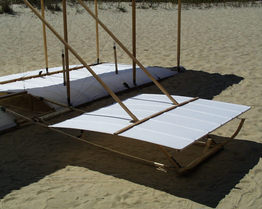
The Wrights raised the elevator off the sand on this
model. The 1900 glider elevator tends to dig into the sand when you land.
|

The kickbar controls the wing warping. The trailing
end of the bar slides against a metal strip under the rear spar. This
keeps the pivot from twisting up and forward as it does on the 1900
glider.
|

Click on the photo to download a video that allows you to "spin" the glider so you can see it
from all sides. You must have a
"Quicktime" plug-in.
|

In addition to the regular landing and flying wires,
the wings are trussed to reduce the camber from 1/12 to 1/20.
The Wrights found the the deeper camber created control problems.
|
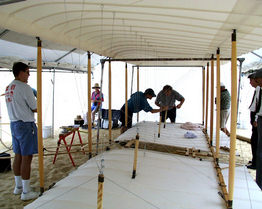
To correct the problem, they attached a third or
"middle" spar to the lower wing, just behind the peak of the
camber. They attached four short "truss posts" to the middle
spar.
|
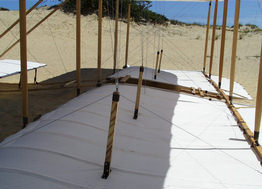
Then they ran wires from the front spar to the rear
spar over the tops of the posts. When they tightened these wires, the
posts pushed down on the middle spar and the spar depressed the
ribs, reducing the camber.
|
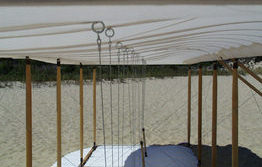
Then the Wrights ran cord from the tops of the posts to the top ribs.
When they tightened these cords, they pulled the ribs down, flattening them
to the same degree as the bottom ribs.
|
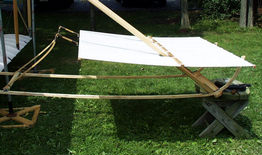
Before we left Dayton, we noticed a strange feature
of the elevator control design. The elevator will lock in a neutral
position if you attempt to turn the nose of the glider down. This may
explain one of the most frightening accidents Wilbur had when flying this
glider.
|

The first time in the air in 1901, Wilbur
could not turn the nose of the glider down and the wind carried him higher
and higher until he stalled. To prevent this from happening to us, we
installed to short wooden "stops" to prevent the controls from
locking.
|
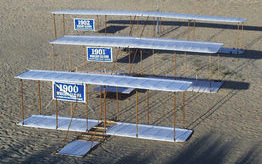
The 1900, 1901, and 1903 Wright gliders from the front.
|

The gliders from the side.
|
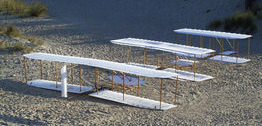
And from the rear. We made this line-up to compare the gliders and
see first-hand the evolution of the Wright brothers' aeronautical
science and engineering.
|
|
|